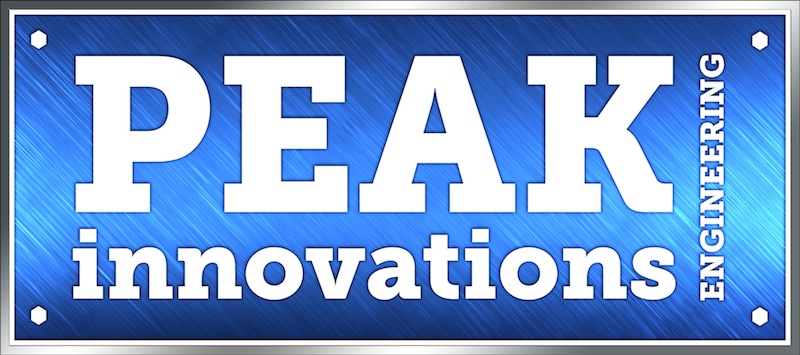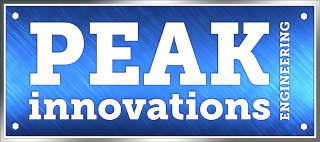Bolted Joint FAQs
by:
Dave Archer | Principal Engineer
Peak Innovations Engineering
9934 N. Alpine Rd., Suite 104
Machesney Park, IL 61115 USA
Two of the most commonly asked questions about fasteners are “When should fine-thread fasteners be used?” and “is it preferable to apply torque to the nut rather than the bolt head?” Many different factors influence those decisions, but here are some basic answers to both questions.
WHEN SHOULD FINE-THREADED FASTENERS BE USED?
For a given fastener diameter, as thread pitch decreases, a bolt’s tensile strength increases because the stress area (the smallest cross-section in the threaded portion of the bolt), becomes larger. This increase is approximately 12 percent for standard pitch differentials and since the helix angle of the thread decreases with finer thread pitch, resistance to vibrational loosening will improve somewhat. The reason is analogous to a snow sled requiring more effort to get moving as a hill becomes flatter. On the other hand, finer threads increase the potential for cross-threading and take more time to insert, because they require more turns Still, it could be argued that the pros outweigh the cons, so why are fine threads not more popular? Many of the obstacles to more widespread use are nontechnical.
First, the combination of fine and coarse threads in an assembly or maintenance environment invariably leads to cross-use are, and the resulting problems are usually disruptive and expensive. Other, more isolated disadvantages can be availability and higher part cost. In many cases, the option was simply never considered. When should fine-thread fasteners be used? The most obvious answer is in applications where weight and size are the overriding drivers in engineering decisions. For example, aircraft engines use fine thread fasteners exclusively because of the increased strength in the same size and weight outweighs all other considerations.
Some manufacturers are missing an opportunity for product improvement with fine-thread fasteners. Good applications are highly engineered products in low to moderate production volumes, where power density, weight, or size is critical. Keep in mind that using higher capacity fasteners does not automatically result in realizing their benefits. Joint testing and manufacturing capability are needed to ensure that their benefits are actually realized.
IS IT PREFERABLE TO APPLY TORQUE TO THE NUT RATHER THAN THE BOLT HEAD? WHY?
In a through-bolted joint, it is generally preferable to turn the nut rather than the bolt head, a key reason is the effect of bolt torsion. When a threaded fastener is tensioned by rotation of either the nut or the fastener itself, torsional stress is created in its shank. How this impacts the nut versus head question can be illustrated with a hypothetical application that magnifies the influence of bolt torsion. Imagine 0.25-inch (M6) stainless steel bolts being used to clamp together two steel plates each 2 inches thick.
If the bolt head were turned and the nut restrained, one could imagine that the combination of a long slender bolt and high thread friction would cause the bolt to twist significantly as torque is applied in fact, the bolt would fail well before the clamp load predicted by the bolt’s tensile strength could be achieved, due to this high torsional stress being added to the tensile stress created by bolt elongation. Remember that the published strength of fastener materials is based on pure tensile loading. The combination of torsion and tension lowers the bolt’s capacity. If the bolt head were instead restrained and the nut rotated, this joint configuration would still result in a high level of torsional stress, though not as great as in the first example, because the torque is applied more directly to the threads, the nut does not “wind up” like the bolt. However, by changing key variables, such as relative friction at the interfaces or the bolt’s length-to-diameter ratio, the relationship between the input torque and resulting clamp load can be varied significantly, to the point where turning the head or nut yields effectively the same result.
So, why is turning the nut preferable? Because turning the nut removes the portion of torsional stress and stored energy created by applying the torque remotely from the threads at the bolt head. This, in turn, results in more predictable and potentially higher clamp loads. Torsional stress reduces the bolt tension that can be achieved during tightening in all applications, not just this extreme example. Fortunately, this loss is often offset by the fact fasteners are generally 10 percent to 20 percent stronger than minimum specifications. As a point of reference, we have seen bolts yield during tightening at clamp loads lower than calculated by the minimum proof load when the nut factor (K factor) is approximately 0.18 or greater.
Company Profile:
Peak Innovations Engineering has a highly technical team to design, test, validate, and enhance the bolted joints within your product application. Joint development and testing are all we do, so we do it better than other available options, both internal and external. Why consume your resources engineering and problem-solving areas that are secondary to your core responsibilities when we can take care of them quickly, definitively, and cost-effectively? www.pieng.com

